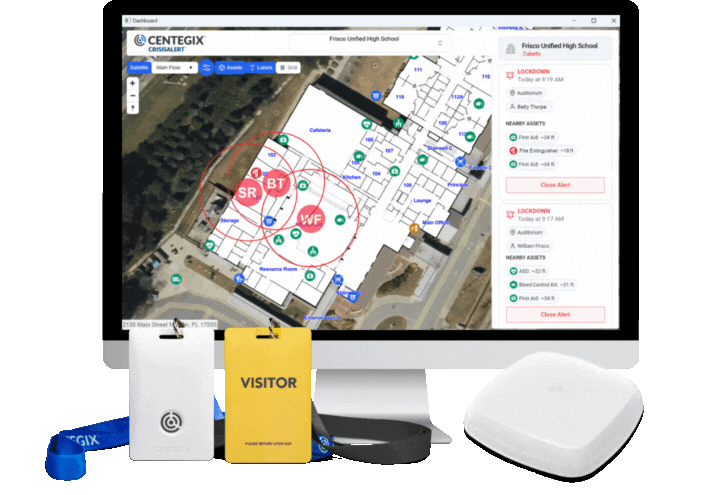Nurses are the heavy lifters of America’s healthcare system. They provide hands-on patient care, assist physicians, and act as liaisons between patients and family members. Unfortunately, their indispensable service is being threatened by the steady rise of violence in healthcare facilities.
The U.S. is expected to experience a shortage of registered nurses (RNs) over the next decade. Many are leaving the field due to the fear of workplace violence and the stress and trauma that result from physical or verbal abuse.
A nursing shortage threatens the level of care provided in hospitals and puts additional strain on the healthcare system. Organizations must take a stand by creating a culture of safety backed by security protocols and technology, like a wearable duress button for every employee. Not only does this keep staff and patients safe, but it also improves nurse retention.
The U.S. Nursing Shortage: An Overview
The US Bureau of Labor Statistics reports that the median annual salary for RNs was $93,000 as of May 2024, and approximately 189,000 openings for RNs are projected each year over the next decade. It’s a rewarding and financially stable career path, but many are giving it up.
Statistics collected from accredited sources and published in the Health Resources and Services Administration’s State of the U.S. Health Care Workforce, 2024 illuminates the shortage problem:
- A 2023 Mayo Clinic survey found that 41% of nurses intend to leave their jobs within two years.
- A 2022 survey by the National Council of State Boards of Nursing (NCSBN) found that 45% of RNs experience feelings of burnout at least a few times a week.
- A US Census Bureau study showed that post-pandemic exit rates for healthcare workers remain higher than pre-pandemic rates.
- The National Center for Health Workforce Analysis (NCHWA) projects a 6% shortage of RNs nationwide and a 13% shortage in nonmetro areas by 2037.
These numbers are daunting given the county’s growing need to support the healthcare demands of an aging population and the rise in chronic illnesses like obesity, heart disease, and diabetes.
Why Are Nurses Leaving the Sector at Such an Alarming Rate?
RegisteredNursing.org reports that the number of RNs needed in the US is expected to grow by 28.4%. While much of the country will be able to meet this demand, states like Georgia, California, and Texas will experience significant shortages.
These statistics beg the question—what’s causing such high levels of burnout and resignation among nurses? Long hours, staffing challenges, and heavy workloads contribute to the problem. However, most aspiring nurses understand these challenges before entering the field. What many don’t anticipate is exposure to workplace violence.
A recent article published by Women’s Health highlights that federal authorities have warned of a national demand for over 63,000 additional nurses by 2030. This shortfall is driven by deteriorating working conditions, including the prevalence of violence. Several nurses interviewed for the article reported that newcomers to the field aren’t equipped to deal with the brutal realities of the job. Adding physical and verbal abuse to an already emotional working environment exacerbates staffing shortages by pushing many new RNs to reconsider their career.
The Overwhelming Cost of Replacing Nurses
In addition to the stress put on existing staff and the decline in quality of care, high nurse turnover rates are expensive. Nurse turnover can drastically eat into a healthcare organization’s budget.
- Lack of retention can cost a hospital up to $5.7 million per year.
- Turnover costs an average of $61,110 per RN.
- Each percentage of reduced RN turnover can lower labor costs by $289,000.
It’s in an organization’s best interest to support workplace violence prevention by implementing tools like a wearable duress button and digital mapping technology. The initial investment yields a long-term payoff when retention rates improve due to enhanced workplace safety. Additionally, a recent report published by the American Hospital Association reported that proactive violence prevention measures reduced overall annual spend compared to reactive investments related to violence in healthcare. The report showed that pre-event annual spend was estimated at $3.6 billion. In contrast, post-event costs were estimated at over 4 times that number, at $14.65 billion, and included costs for healthcare, staffing, replacement and repair of infrastructure and equipment, legal costs, and community and public relations costs. “The largest contributor to total annual costs came from post-event healthcare expenses to treat violent injuries,” the report stated.
This data shows that proactive violence prevention measures not only reduce incidents of violence but also substantially reduce associated costs.
Perceptions of Workplace Safety Efforts
Support is a key component of a safe work culture. Healthcare professionals should have no doubt that employers have a reliable safety infrastructure in place. Unfortunately, this isn’t always the case.
The American College of Emergency Physicians interviewed 1,980 of its members on the prevalence of violence in emergency rooms. The following statistics, published in a 2024 report, reveal an imbalance between the frequency of violence and hospital responsiveness:
- Over 91% of emergency physicians indicated that they’ve been threatened or attacked in the past year.
- 71% said workplace violence in their emergency room is worse than the previous year.
- 68% said their employer’s response to violence was insufficient.
Other studies have shown that this negative perception of healthcare organizations’ safety efforts is echoed in the nursing community. A survey conducted by McKinsey & Company revealed that safety is the most significant factor for RNs considering whether or not to stay in their current position, outranking work-life balance, a caring team, and flexible schedules.
To combat the nursing shortage, healthcare organizations must pivot from a reactive to a proactive approach to safety. By prioritizing nurse safety with solutions like a wearable duress button, hospitals can boost retention and move the needle on violence prevention.
CENTEGIX: Your Healthcare Partner in Workplace Violence Prevention
The CENTEGIX Safety Platform® is the center of a hospital’s layered safety plan. It’s a cloud-based solution that integrates a wearable duress button, dynamic facility mapping, visitor management, and accessible reporting into a comprehensive safety solution.
- CrisisAlert™ is a wearable duress button that empowers healthcare professionals to signal for help at any time. Nurses can quickly and discreetly notify staff and security personnel of their exact location, improving response times and supporting the de-escalation of workplace violence. CrisisAlert also opens an incident report each time an alert is sent, making it easy to spot trends and enable data-driven safety decisions.
- CENTEGIX Safety Blueprint® displays a digital floor plan of a facility so safety teams and first responders can pinpoint the exact location of an incident. It also shows the location of safety assets like security cameras, access control doors, and emergency exits—invaluable when creating or updating a safety plan.
- Enhanced Visitor Management enables healthcare facilities to check in, authenticate, and locate visitors in real time. It provides facility-wide visibility for administrators and screens visitors against designated registries and watchlists.
The CENTEGIX Safety Platform integrates with existing safety assets, optimizing workplace violence prevention and accelerating incident response.
CENTEGIX Drives Accountability Through Automation
Accountability is a core ingredient in any workplace violence prevention plan. Healthcare organizations must take responsibility for the well-being of employees by integrating the right technology and strategic safety protocols.
Emergency responsiveness and incident reporting are invaluable safety components that can’t be overlooked. CENTEGIX automates these processes to protect nurses and other healthcare professionals from traumatic workplace violence and gives safety teams the data they need to make informed improvements.
The CrisisAlert wearable duress button makes it easy for nurses to get the help they need when seconds matter. It also provides a reliable reporting solution so healthcare organizations remain accountable for each incident that threatens the well-being of employees.
Safety Solutions That Support Nurse Retention
Hospitals that invest in the safety of their staff experience higher nurse retention, improve the quality of care provided, and enhance the work culture.
Kala Bettis, Integrated Behavioral Health Supervisor at Vail Health Behavioral Health, spoke to this in an AHA Forum on workplace violence in 2024. She says, “It goes back to what the very top of our organization (our entire executive leadership team) has said. We really believe in our retention rates being strong. We believe in this place being something special and wanting to provide the highest level of care possible in this community and continuing to do so. And that comes from investing in our employees. And you invest in your employees based on them feeling safe and confident in the work that they know how to do the best.”
CENTEGIX Safety Platform facilitates nurse retention in several ways:
- The CrisisAlert wearable duress button gives nurses the confidence that their employer supports their safety and that a rapid emergency response solution is in place to help them when they are in need.
- Digital safety solutions remove safety silos, making workplace violence prevention a shared responsibility that starts with the leadership team.
- Data collection supports informed decisions regarding safety protocols and staff scheduling.
- Creating a safe work culture improves employee well-being and enhances the reputation of the healthcare organization in the eyes of prospective employees.
By investing in the CENTEGIX Safety Platform, healthcare organizations take an important step toward preventing workplace violence and retaining nurses.
Support Nurse Safety With a Reliable Wearable Duress Button
Ready to streamline workplace violence prevention with a wearable duress button your nurses can count on? Learn more about CrisisAlert as a solution for fast and effective emergency response.












